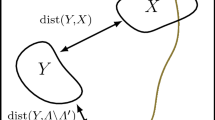Abstract
We prove the validity of linear response theory at zero temperature for perturbations of gapped Hamiltonians describing interacting fermions on a lattice. As an essential innovation, our result requires the spectral gap assumption only for the unperturbed Hamiltonian and applies to a large class of perturbations that close the spectral gap. Moreover, we prove formulas also for higher order response coefficients. Our justification of linear response theory is based on a novel extension of the adiabatic theorem to situations where a time-dependent perturbation closes the gap. According to the standard version of the adiabatic theorem, when the perturbation is switched on adiabatically and as long as the gap does not close, the initial ground state evolves into the ground state of the perturbed operator. The new adiabatic theorem states that for perturbations that are either slowly varying potentials or small quasi-local operators, once the perturbation closes the gap, the adiabatic evolution follows non-equilibrium almost-stationary states (NEASS) that we construct explicitly.
Similar content being viewed by others
References
Bachmann S., Bols A., De Roeck W., Fraas M.: Quantization of conductance in gapped interacting systems. Annales Henri Poincaré 19, 695–708 (2018)
Bachmann S., De Roeck W., Fraas M.: The adiabatic theorem and linear response theory for extended quantum systems. Commun. Math. Phys. 361, 997–1027 (2018)
Bachmann S., Michalakis S., Nachtergaele B., Sims R.: Automorphic equivalence within gapped phases of quantum lattice systems. Commun. Math. Phys. 309, 835–871 (2012)
Bellissard J., van Elst A., Schulz-Baldes H.: The noncommutative geometry of the quantum Hall effect. J. Math. Phys. 35, 5373–5451 (1994)
Bouclet J., Germinet F., Klein A., Schenker J.: Linear response theory for magnetic Schrödinger operators in disordered media. J. Funct. Anal. 226, 301–372 (2005)
Bru, J.-B., de Siqueira Pedra, W.: Lieb–Robinson Bounds for Multi-Commutators and Applications to Response Theory. Springer Briefs in Mathematical Physics Vol. 13, Springer (2016)
De Nittis, G., Lein, M.: Linear Response Theory: An Analytic-Algebraic Approach. Springer Briefs in Mathematical Physics Vol. 21, Springer (2017)
de Roeck, W., Salmhofer, M.: Persistence of exponential decay and spectral gaps for interacting fermions. Communications in Mathematical Physics, Online First (2018)
Elgart A., Schlein B.: Adiabatic charge transport and the Kubo formula for Landau-type Hamiltonians. Commun. Pure Appl. Math. 57, 590–615 (2004)
Graf, G.M.: Aspects of the integer quantum Hall effect. In Proceedings of Symposia in Pure Mathematics 76: 429, American Mathematical Society (2007)
Hastings, M.: The Stability of Free Fermi Hamiltonians. Preprint available at arXiv:1706.02270 (2017)
Hastings M., Wen X.-G.: Quasiadiabatic continuation of quantum states: The stability of topological ground-state degeneracy and emergent gauge invariance. Phys. Rev. B 72, 045141 (2005)
Kato T.: On the convergence of the perturbation method. I. Prog. Theor. Phys. 4, 514–523 (1949)
Klein, A., Lenoble, O., Müller, P.: On Mott’s formula for the ac-conductivity in the Anderson model. Ann. Math. 549–577 (2007)
Kubo R.: Statistical-mechanical theory of irreversible processes. I. General theory and simple applications to magnetic and conduction problems. J. Phys. Soc. Japan 12, 570–586 (1957)
Laughlin R.: Anomalous quantum Hall effect: an incompressible quantum fluid with fractionally charged excitations. Phys. Rev. Lett. 50, 1395–1398 (1983)
Lieb E., Robinson D.: The finite group velocity of quantum spin systems. Commun. Math. Phys. 28, 251–257 (1972)
Monaco D., Teufel S.: Adiabatic currents for interacting fermions on a lattice. Rev. Math. Phys. 31, 1950009 (2019)
Nachtergaele B., Sims R., Young A.: Lieb–Robinson bounds, the spectral flow, and stability of the spectral gap for lattice fermion systems. Math. Problems Quantum Phys. 117, 93 (2018)
Nenciu G.: On asymptotic perturbation theory for quantum mechanics: almost invariant subspaces and gauge invariant magnetic perturbation theory. J. Math. Phys. 43, 1273–1298 (2002)
Panati G., Spohn H., Teufel S.: Space-adiabatic perturbation theory in quantum dynamics. Phys. Rev. Lett. 88, 250405 (2002)
Panati G., Spohn H., Teufel S.: Space-adiabatic perturbation theory. Adv. Theor. Math. Phys. 7, 145–204 (2003)
Panati G., Spohn H., Teufel S.: Effective dynamics for Bloch electrons: Peierls substitution and beyond. Commun. Math. Phys. 242, 547–578 (2003)
Simon, B.: Fifteen Problems in Mathematical Physics. Perspectives in Mathematics, Birkhäuser, Basel 423 (1984)
Teufel, S.: Adiabatic Perturbation Theory in Quantum Dynamics. Lecture Notes in Mathematics 1821, Springer, Berlin (2003)
Acknowledgements
I am grateful to Giovanna Marcelli, Domenico Monaco, and Gianluca Panati for their involvement in a closely related joint project. I would like to thank Horia Cornean, Vojkan Jaksic, Jürg Fröhlich, and Marcello Porta for very valuable discussions and comments. This work was supported by the German Science Foundation within the Research Training Group 1838.
Author information
Authors and Affiliations
Corresponding author
Additional information
Communicated by M. Salmhofer
Publisher’s Note
Springer Nature remains neutral with regard to jurisdictional claims in published maps and institutional affiliations.
Rights and permissions
About this article
Cite this article
Teufel, S. Non-equilibrium Almost-Stationary States and Linear Response for Gapped Quantum Systems. Commun. Math. Phys. 373, 621–653 (2020). https://doi.org/10.1007/s00220-019-03407-6
Received:
Accepted:
Published:
Issue Date:
DOI: https://doi.org/10.1007/s00220-019-03407-6



